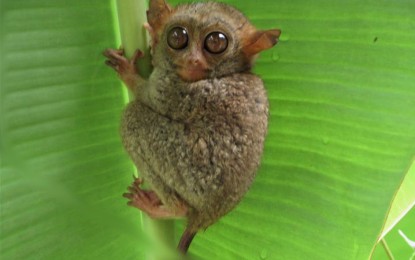
TARSIER. The Protected Area Management Office of the Mt. Matutum Protected Landscape (PAMO-MMPL) has limited the entry of visitors to the tarsier sanctuary in Barangay Linan, Tupi town in South Cotabato province to protect the critical primate and its habitat. It prohibited the entry of walk-in visitors to the site as part of their enhanced conservation and protection measures. (Photo courtesy of PAMO-MMPL)
GENERAL SANTOS CITY -- Environment personnel have limited the entry of visitors to a declared tarsier sanctuary on Mt. Matutum in South Cotabato province in a bid to protect the critical primate and its habitat.
Forester Gabriel Baute, area superintendent of the Mt. Matutum Protected Landscape (MMPL), said Thursday they stopped accommodating walk-in visitors at the sanctuary in Barangay Linan, Tupi starting this holiday season as part of their enhanced conservation and protection program.
He said the influx of visitors might disturb the tarsiers, dubbed the world’s smallest primate, and threaten their natural habitat.
Baute cited that tarsiers are nocturnal animals, normally sleeping during the day and active only during the night, like owls.
“Hence, visitors are enjoined to avoid disturbing these animals in their natural habitat or when visiting the tarsier sanctuary,” he said in a statement.
Baute said like other wildlife species, tarsiers are best left in their natural habitat rather than being captured and caged as pets.
Tarsiers are known to commit suicide when in captivity and exposed to stressors like camera flash, human touch, and other forms of disturbance, he said.
It is listed under “near threatened species” by the International Union for the Conservation of Nature.
In response to the move, the municipal government of Tupi has adopted a program dubbed “voluntourism,” which mainly raises awareness on the need to protect the tarsiers and their sanctuary.
Visits to the site are currently allowed through pre-arranged schedules with the Municipal Environment and Natural Resources Office (Menro).
Rolando Visaya, Tupi Menro chief, said the program promotes the principles of volunteerism and responsible tourism.
Through the program, he said they tap visitors to help plant trees at the site and its immediate environs.
Their primary targets are individuals with high regard and motivation for the protection and conservation of biodiversity, especially the tarsiers, he said.
“This gives our visitors the opportunity to see the tarsiers in their natural habitat and at the same time take part in protecting them,” he said.
Mt. Matutum is a known sanctuary of tarsiers, which are called “mal” by Blaan and Tboli tribal residents in the area.
The area is part of the 13,947-hectare MMPL, which covers the municipalities of Tupi, Tampakan, and Polomolok in South Cotabato and Malungon in Sarangani province.
The Department of Environment and Natural Resources declared parts of Barangay Linan, Tupi as a tarsier sanctuary by virtue of Proclamation 1030 signed by former president Fidel Ramos on June 23, 1997.
It declared the Philippine Tarsier (Tarsius syrichta) as specially-protected faunal species mandated the establishment of appropriate sanctuaries to preserve and protect them. (PNA)
